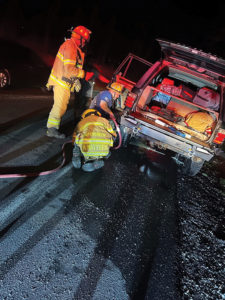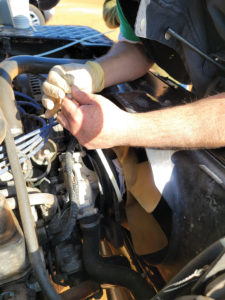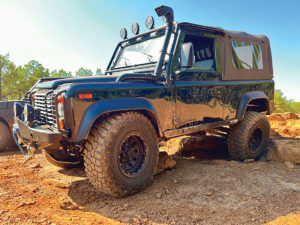Over the 30 days of April, travel to Land Rover events took me to New York, East Texas, San Fransisco & the Sonoma Valley and the Blue Ridge Mountains of Virginia. Airlines delivered me to the events, so I spent considerable time in the passenger’s seat. That gave me ample time to admire the talents and commitment of so many enthusiasts. Let me share a couple of notable examples.
On a steep ascent at SCARR, Caleb Reynolds, S. Austin, TX, snapped a passenger-side rear axle shaft [See p.___ in this issue -ed] on LuLu, his Discovery II. He showed ingenuity in accomplishing an onsite repair – having experienced the same problem at the Great American Rover Rally in Moab last year, he made certain he came prepared just in case.
As Caleb told me, “Ever since that event, I make sure to take my tools, wood blocks, spare axles, hubs and axle nuts with me. I had most of the needed tools but forgot to bring two things: a 10pt, 13mm socket (for caliper bracket bolts) and a Phillips-head screwdriver large enough to remove the rotor retention screw. Caleb Lourias and Justin Monnin had the tools I needed, and Chad Street loaned me jack stands.”
“After we got off the trail, I drove to a flat area and lifted the rear. As the passenger rear tire spun freely when the driver rear was on the ground, I knew it was the culprit. I removed the tire, followed by the brake caliper bracket (tied up and out of the way) and brake rotor; finally, I unbolted the 4 hub bolts and slid out the hub and axle assembly together. (I find that removing the hub and axle together is fastest. Since it would be difficult to separate them on the trail, I make sure to carry separated hubs and axles. That way I can reassemble as needed.) I inserted the new axle, slid on the hub, tightened it with a loaner electric impact gun, bolted the hub down, re-installed the rotor and caliper bracket and then tightened the wheel. When I put the truck down, I used my 2 ft breaker bar to finish tightening the hub bolt. Then I pinged the hub nut to lock it in place.”
“Once I found the tools I needed, the job took about 30 minutes. The Land Rover community was awesome in helping Lulu get back on the trail to wheel. After I put her back together, we got back in line for the next scheduled trail run and kept wheeling! I had driven LuLu five hours from Austin to the rally and I drove her home without issue.”
An even more dramatic repair occurred at ROAV at Wintergreen later that month. Ronald Saba, Alexandria, VA, and family traveled to Wintergreen in their Range Rover P38A, “Coco.” Here is the story of Coco’s field repair at Wintergreen.
Vanessa Saba told me, “While driving up the mountain road to register for Wintergreen, we kept smelling something, but Ronald and I thought it must’ve been an old truck going up the hill. The P38 kept chugging along, and I kept smelling a strange odor – was it smoke, a hard-working engine or hot brakes? As we passed the Wintergreen Fire Station, Ronald realized the smell was coming from our Range Rover. When he popped up the hood, white smoke just poured out. Suddenly, a female driver behind us yells, ‘Dude, you’re on fire! Your truck’s on fire!’ As soon as we heard that, I got Isaac, age 6, and RJ, age 13, our of our Range Rover. Ronald quickly ran for some water bottles and began throwing water at the flames, which came from the left rear quarter of the vehicle. That’s when the Fire Department arrived and sprayed the underside of the car with water.”
“Once the Range Rover cooled down, Ronald found out his center muffler had blown out due to rust. The heat from the exhaust had blown toward and melted the left rear brake hose. It also ignited the ABS wires and the brake lines. Ingenuity and good fortune enabled him to make the repair. David Short, ROAV’s president, loaned us wire and crimping tools to reconnect the ABS system. Our friend, Edwin Herrera, had a spare brake hose in his P38A. The next morning, Ronald purchased some HVAC aluminum and exhaust putty, and he ‘MacGyvered’ the P38 such that we made the trails all weekend.”
Rebelle Rally competitor Kristin Thul, Ft. Worth, TX, took her ’95 NAS Defender 90 on the Barbara Toy Run, a women-driver only trail drive held annually at SCARR. Once on the trails, she discovered that at low speeds, her Defender ran hot and threatened to overheat. She finished the run but expressed concern as her long drive home loomed ahead. Darrell Oliver diagnosed the issue as a weakening fan clutch [a viscous coupling activates the engine fan when the cooling system reaches a certain temperature -ed.] Mechanic Hector Gonzales effected a brilliant field repair. He soaked a facecloth with water, squeezed out the excess and rolled it tightly into a tubular shape. Then, he wrapped it between the fan shaft and the plastic flange of the fan. Taking two of the largest zip ties I’ve ever seen, he tightened the cloth to create enough friction for the fan to turn. [Memo to self: pack a facecloth/shop towel and longer, wider zip ties inside the Discovery I -ed]. A relieved Kristin said the Defender never lost its cool for the remainder of the weekend or her trip home.
With all the travel, I spent little time behind the steering wheel of my own Land Rovers. They let me know how ticked off they were at my neglect.
On one brief period at home between trips, I jumped from Land Rover to Land Rover in an effort to drive one of them on a dump run. I started with the ‘67 109” SW. As it’s parked on an incline, the fuel evaporates from the carb bowl and the fuel pump does not have the draw to pull fuel from the rear-only tank. Rather than fiddle with it at that time, I turned to the ’66 Series IIA 88”. It runs a fan belt sourced from our local boatyard and now signals its start up and forward motion with an inglorious squeal. I could not make the three-mile dump run howling like a banshee. (A proper fan belt arrived later from Rovers North.) The ’97 Discovery I had sat for two weeks and now the battery would put out only 9.9 volts; it required a few hours hooked up to a battery charger before it begrudgingly carted me to the dump.
I named my Discovery I “Gilroy” to honor Tony Gilroy, the man often credited with keeping Land Rover British. We said good-bye to him in late March at age 85. A native of Cork, Ireland, Gilroy started his life in the automotive sector with Ford, then moved to Austin Rover and, in 1983, to head up Land Rover. Within a few months, he had identified a core problem for the marque. Some 75% of its sales went to nations in Africa, the Middle East and the Far East, whose commodity-based economies suffered from low prices and a strong British pound. Put simply, Land Rover was losing sales and needed to find new markets.
In 1983, as Managing Director of Land Rover, Gilroy quickly developed a plan to make the company more successful. He looked to increase Land Rover’s market penetration in Europe and Australia, bring Land Rovers to Japan and find a way to increase sales in the large North American market.
He found a market segment between the Land Rover 90/110 and the premium Range Rover that other manufacturers had entered; 36 months later – startling speed for the staid British Leyland – “Project Jay” had designed and manufactured the Discovery. It shared components, such as engines and drivetrains, with the Range Rover (which could then become more luxurious and profitable), and more mundane items like door handles and interior switches with other British Leyland vehicles. Gilroy also consolidated manufacturing from satellite factories to the Solihull site. The launch of the Discovery in 1989 provided badly needed funds for the company. In 1994, that Discovery I drivetrain would become the underpinnings of the NAS Defender 90, enabling Range Rover North America to broaden its offerings and become Land Rover North America.
Ironically, Tony Gilroy left the company in a corporate management shake-up just before the 1989 Discovery launch, so he could only view its success from afar. He could take pride in his role in helping fend off General Motor’s bid to purchase Land Rover from British Leyland. The Discovery is still the keystone of the company’s success; today, Jaguar Land Rover remains the most important British automotive manufacturer.
Tony got it right. And “Gilroy” brings a smile to my face every time I drive it, whether for work or pleasure.




